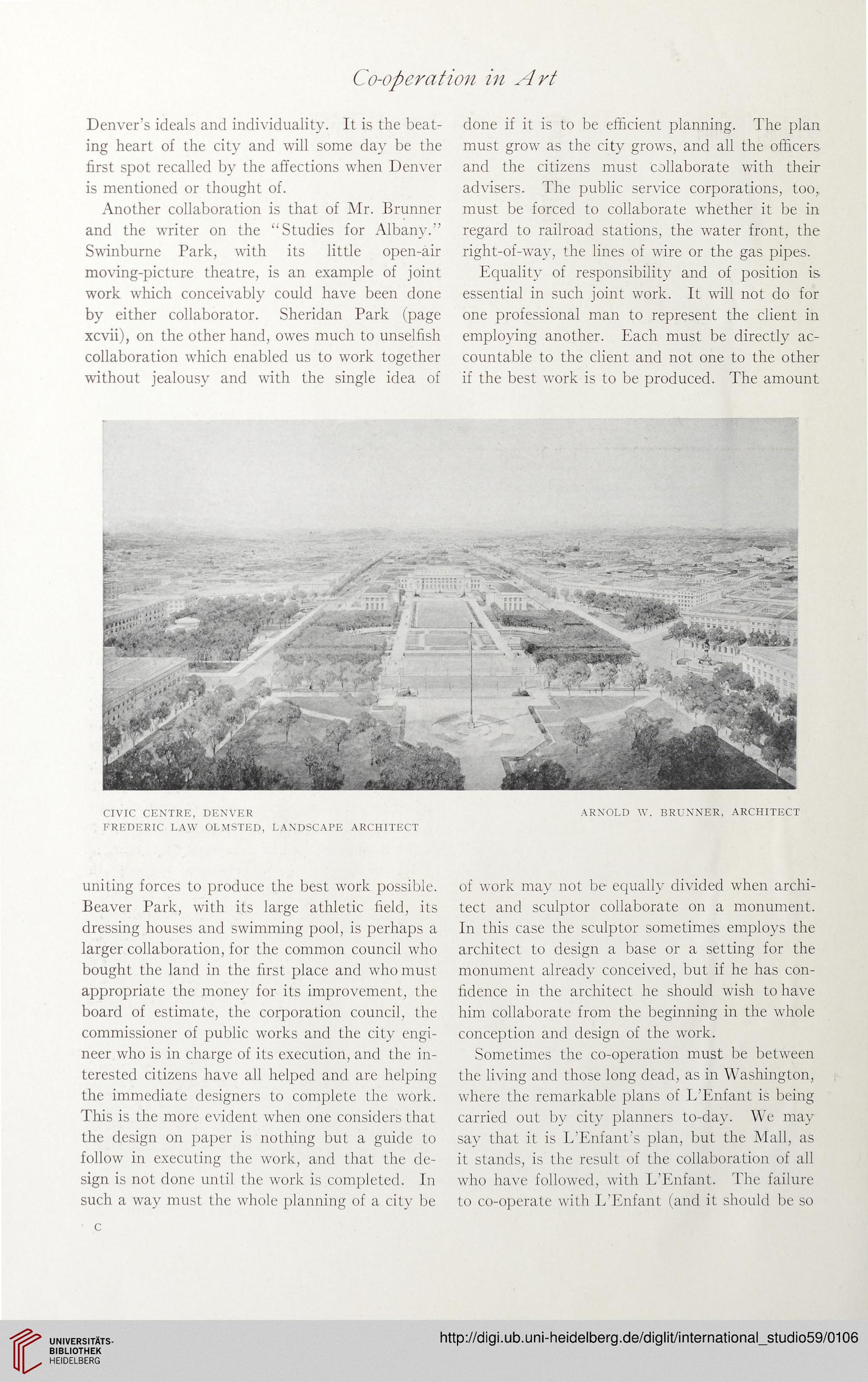Co-operation in Art
Denver’s ideals and individuality. It is the beat-
ing heart of the city and will some day be the
first spot recalled by the affections when Denver
is mentioned or thought of.
Another collaboration is that of Mr. Brunner
and the writer on the “Studies for Albany.”
Swinburne Park, with its little open-air
moving-picture theatre, is an example of joint
work which conceivably could have been done
by either collaborator. Sheridan Park (page
xcvii), on the other hand, owes much to unselfish
collaboration which enabled us to work together
without jealousy and with the single idea of
done if it is to be efficient planning. The plan
must grow as the city grows, and all the officers
and the citizens must collaborate with their
advisers. The public service corporations, too,
must be forced to collaborate whether it be in
regard to railroad stations, the water front, the
right-of-way, the lines of wire or the gas pipes.
Equality of responsibility and of position is
essential in such joint work. It will not do for
one professional man to represent the client in
employing another. Each must be directly ac-
countable to the client and not one to the other
if the best work is to be produced. The amount
CIVIC CENTRE, DENVER
FREDERIC LAW OLMSTED, LANDSCAPE ARCHITECT
ARNOLD W. BRUNNER, ARCHITECT
uniting forces to produce the best work possible.
Beaver Park, with its large athletic field, its
dressing houses and swimming pool, is perhaps a
larger collaboration, for the common council who
bought the land in the first place and who must
appropriate the money for its improvement, the
board of estimate, the corporation council, the
commissioner of public works and the city engi-
neer who is in charge of its execution, and the in-
terested citizens have all helped and are helping
the immediate designers to complete the work.
This is the more evident when one considers that
the design on paper is nothing but a guide to
follow in executing the work, and that the de-
sign is not done until the work is completed. In
such a way must the whole planning of a city be
of work may not be equally divided when archi-
tect and sculptor collaborate on a monument.
In this case the sculptor sometimes employs the
architect to design a base or a setting for the
monument already conceived, but if he has con-
fidence in the architect he should wish to have
him collaborate from the beginning in the whole
conception and design of the work.
Sometimes the co-operation must be between
the living and those long dead, as in Washington,
where the remarkable plans of L’Enfant is being
carried out by city planners to-day. We may
say that it is L’Enfant’s plan, but the Mall, as
it stands, is the result of the collaboration of all
who have followed, with L’Enfant. The failure
to co-operate with L’Enfant (and it should be so
Denver’s ideals and individuality. It is the beat-
ing heart of the city and will some day be the
first spot recalled by the affections when Denver
is mentioned or thought of.
Another collaboration is that of Mr. Brunner
and the writer on the “Studies for Albany.”
Swinburne Park, with its little open-air
moving-picture theatre, is an example of joint
work which conceivably could have been done
by either collaborator. Sheridan Park (page
xcvii), on the other hand, owes much to unselfish
collaboration which enabled us to work together
without jealousy and with the single idea of
done if it is to be efficient planning. The plan
must grow as the city grows, and all the officers
and the citizens must collaborate with their
advisers. The public service corporations, too,
must be forced to collaborate whether it be in
regard to railroad stations, the water front, the
right-of-way, the lines of wire or the gas pipes.
Equality of responsibility and of position is
essential in such joint work. It will not do for
one professional man to represent the client in
employing another. Each must be directly ac-
countable to the client and not one to the other
if the best work is to be produced. The amount
CIVIC CENTRE, DENVER
FREDERIC LAW OLMSTED, LANDSCAPE ARCHITECT
ARNOLD W. BRUNNER, ARCHITECT
uniting forces to produce the best work possible.
Beaver Park, with its large athletic field, its
dressing houses and swimming pool, is perhaps a
larger collaboration, for the common council who
bought the land in the first place and who must
appropriate the money for its improvement, the
board of estimate, the corporation council, the
commissioner of public works and the city engi-
neer who is in charge of its execution, and the in-
terested citizens have all helped and are helping
the immediate designers to complete the work.
This is the more evident when one considers that
the design on paper is nothing but a guide to
follow in executing the work, and that the de-
sign is not done until the work is completed. In
such a way must the whole planning of a city be
of work may not be equally divided when archi-
tect and sculptor collaborate on a monument.
In this case the sculptor sometimes employs the
architect to design a base or a setting for the
monument already conceived, but if he has con-
fidence in the architect he should wish to have
him collaborate from the beginning in the whole
conception and design of the work.
Sometimes the co-operation must be between
the living and those long dead, as in Washington,
where the remarkable plans of L’Enfant is being
carried out by city planners to-day. We may
say that it is L’Enfant’s plan, but the Mall, as
it stands, is the result of the collaboration of all
who have followed, with L’Enfant. The failure
to co-operate with L’Enfant (and it should be so




